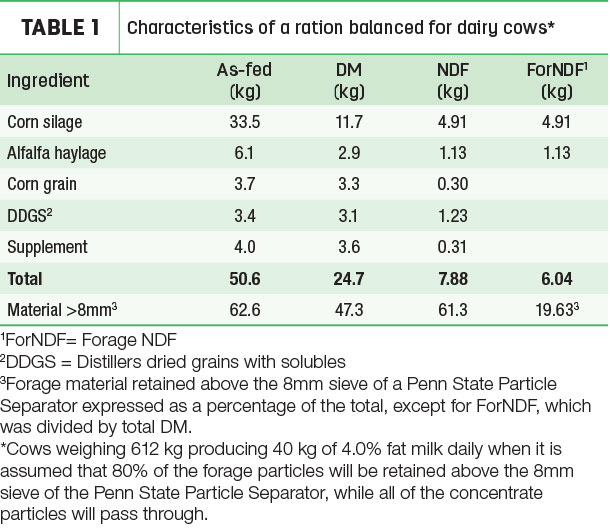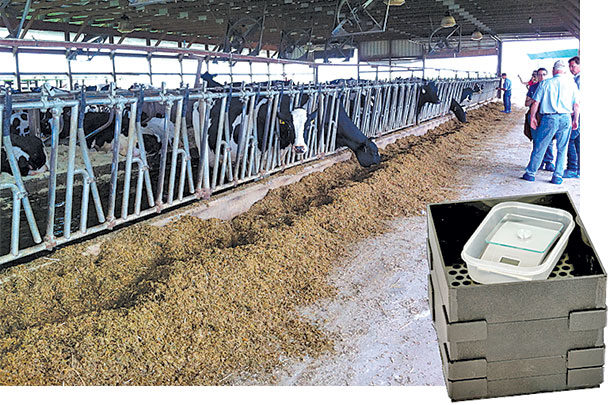However, defining an absolute dietary requirement for fibre that can be used in ration formulation or evaluation has been challenging due to the complexity of understanding the exact or dominant function of fibre in the rumen.
Nutritional role of fibre
In short, feed particles of sufficient size, from forages and some byproducts, fill the rumen and form a floating mat in the rumen. As intake increases, the rumen mat presses against the front area of the rumen around the opening of the esophagus and stimulates both rumen motility and the desire for the animal to ruminate.
Chewing during rumination produces saliva that helps neutralize volatile fatty acids (VFAs) produced during fermentation, thereby helping maintain an optimal pH level in the rumen.
The motility of the rumen is also important to enhance VFA absorption across the rumen wall as well as passage in the fluid that flows from the rumen through the reticulo-omasal orifice, which also helps maintain rumen pH.
In the past, maintenance of rumen pH was thought to be important for supporting milkfat production by maintaining fibre digestion. More recently, we understand it is the effect of low rumen pH on trans-fatty acid production that primarily affects milkfat.
The challenge at present is to develop fibre requirements that ensure optimal levels of rumen pH but do not needlessly inhibit dry matter intake (DMI).
Methods of defining fibre requirements
Early methods to define fibre requirements included minimum forage-to-concentrate ratios (e.g., 40 to 60) and, subsequently, minimum dietary acid and neutral detergent fibre (ADF and NDF) contents (e.g., 16 and 25 percent total diet ADF and NDF, respectively, with 19 percent of total diet NDF [i.e., 75 percent of the NDF] coming from forages).
While these recommendations have had widespread application, they have had variable success in maintaining rumen pH and milkfat since not all NDF has the same chemical or physical characteristics, nor digestion characteristics, within the rumen – nor do they address maximum levels of fibre (forage) intake.
The development of the Penn State Particle Separator (PSPS), which separates feed into particle-size fractions, provided a simple tool for evaluation of particle size both for research and on the farm.
Researchers in 1997 proposed the effect of particle size distribution and fibre content of the diet could be combined into a single measure called physically effective NDF (peNDF) by expressing the proportion of the diet retained above a 1.18-millimetre sieve (i.e., peNDF greater than 1.18). This concept was later adapted to the PSPS to also give peNDF greater than 8 and peNDF greater than 19.
These measures have subsequently been shown to have meaningful relationships with rumen pH and chewing behaviour, but may be a challenge to apply on-farm.
Effect of peNDF on rumen function
A few years ago, researchers analyzed the results of numerous studies to determine the effects of both peNDF greater than 1.18 and peNDF greater than 8 on rumen pH.
In the first study, average daily rumen pH increased in a linear fashion with peNDF greater than 1.18 and reached a plateau of 6.27 at a peNDF greater than 1.18 of 31.2 percent.
In the second study, rumen pH reached a plateau of 6.22 at a peNDF greater than 8 of 18.5 percent, while DMI began to decline at a peNDF greater than 8 of 14.9 percent, presumably due to too much forage in the rations.
The authors concluded there may be a trade-off between optimal rumen function (i.e., pH) and DMI.
The use of peNDF greater than 8 for understanding rumen function and as a potential parameter for ration formulation is also supported by chewing behaviour observations made by a researcher in 2018 who states “… long particles [greater than 19 millimetres] have a greater effect on eating time, whereas intake of forage neutral detergent fibre [NDF] and medium particles [4 to 19 millimetres] affects rumination time.”
Thus, having adequate amounts of particles above a given size (mostly from forages) is expected to stimulate mat formation, rumination and rumen motility, and thereby mitigate the pH-lowering effects of VFAs produced from organic matter digestion in the rumen.
Challenges with measuring peNDF on farm
The establishment of a significant relationship between peNDF greater than 8 and rumen pH provides a potential for this measure to be used in ration formulation to set a “fibre” requirement to ensure optimal rumen function as well as a maximum so as to not inhibit DMI.
However, the original application of this method calls for the results to be expressed on a dry matter (DM) basis, i.e., to be determined as the amount of DM retained on each tray or sieve multiplied by the NDF content of TMR ration.
While this may be a close approximation for a single ingredient, it may not be accurate for a TMR that may contain different amounts of ingredients with differing NDF contents on each sieve (e.g., ground grains or byproducts versus forages).
In the strictest sense, the NDF content of the material on each sieve should be determined and then multiplied by the proportion of DM retained on that sieve to give a true peNDF value. This has not even been routinely done in most research studies.
In contrast to the research method of determining particle size and peNDF on a DM basis, most on-farm application of the PSPS is on an as-fed basis – and it may not be practical to expect on-farm practitioners to dry material retained on each sieve before calculating particle size distribution.
This introduces a potential disparity in the on-farm application of peNDF research results in cases where the moisture content of the ingredients retained on each sieve may differ significantly, such as when haylages or silages are mixed with dry concentrates. This would be especially important when evaluating the characteristics of TMRs following delivery to the feedbunk.
Formulating rations with peNDF on-farm
Alternatively, as with calculating forage NDF as a percentage of total diet DM, it should be possible to determine or calculate a peNDF greater than 8 value for each ingredient in a ration and then determine the peNDF greater than 8 value for the ration, and even set minimum and maximum constraints within which to balance a ration, and then possibly use as-fed characteristics to evaluate such a ration in the feedbunk.
An example of such a formulation exercise is shown in Table 1.

By dividing 80 percent (amount retained above an 8-millimetre sieve) of the amount of corn silage and haylage by the total amount in each column, one gets the expected amount of as-fed material that should be retained above the 8-millimetre sieve, assuming additional water is not added.
In the fourth column, dividing 80 percent of the amount of corn silage and haylage NDF (i.e., in this case also ForNDF) by the total DM amount (column 2), one gets a peNDF greater than 8 comparable to that described for researchers above.
How well the formulated as-fed greater than 8, DM greater than 8 and peNDF greater than 8 are expressed in the TMR delivered to the feedbunk will be determined by how much particle breakdown occurs during the mixing process.
This will have to be determined in each case and formulation adjustments made accordingly.
For all practical purposes, the material retained above the 8-millimetre sieve of a PSPS is likely to be forage particles of sizes that are restricted from passage from the rumen and that will be entrapped in the rumen mat where they will stimulate both rumination and rumen motility and help optimize rumen pH.
Expressing this material as peNDF greater than 8 appears to provide an opportunity to refine the formulation of fibre requirements a step further than simply total and ForNDF. ![]()
PHOTO: The Penn State Particle Separator, or equivalent, can be used for both formulating and evaluating fibre requirements in lactating dairy rations. Photo illustration courtesy of Jaylor.

-
Alan S. Vaage
- Ruminant Nutritionist
- Jaylor Fabricating Inc.










